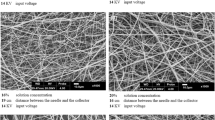Abstract
In this study, PLA nanofibres with unique microstructures were prepared by coaxial electrospinning. The cross-section of the prepared PLA nanofibres exhibited either a surface-porous hollow structure (SPH-PLA) or a surface-porous lotus-root-like structure (SPL-PLA). The morphology, hollow proportion, and porosity of the fibres under different electrospinning parameter conditions were analysed quantitatively; further, three-dimensional (3D) models of the PLA nanofibres were established under parameter conditions that provided the highest hollow proportion. The results of the analysis revealed that the diameter fluctuated only slightly with the process parameters. Additionally, variations in the different electrospinning parameters caused only a slight change in the surface porosity (i.e. only 31% ± 4%) of the PLA fibres. The total porosity of the section (termed the pore porosity), porosity of the hollow section (termed the hollow porosity), R value (R = hollow porosity/pore porosity), and number of small pores of the SPH-PLA nanofibres did not change significantly with the receiving distance; the change observed was approximately only by 38% ± 2%, 28% ± 2%, 75% ± 5%, and 11 ± 1, respectively. Further, the cross-sectional porosity of the SPL-PLA nanofibres also did not change significantly with the receiving distance, only by approximately 24% ± 2%. The hollow proportion was the highest (76.32% ± 8.34%) at a core/shell flow rate ratio of 0.3:0.9 (mL/h), spinning voltage of 19 kV, and receiving distance of 6 cm. Therefore, 3D models of the SPH-PLA and SPL-PLA nanofibres were established under these electrospinning parameters.























Similar content being viewed by others
References
Alharbi HF, Luqman M, Fouad H, Khalil KA, Alharthi NH (2018) Viscoelastic behavior of core-shell structured nanofibres of PLA and PVA produced by coaxial electrospinning. Polym Test 67:67–143. https://doi.org/10.1016/j.polymertesting.2018.02.026
Ball C, Chou SF, Jiang Y, Woodrow KA (2016) Coaxially electrospun fibre-based microbicides facilitate broadly tunable release of maraviroc. Mater Sci Eng C 63:117–124. https://doi.org/10.1016/j.msec.2016.02.018
Bognitzki M, Czado W, Frese T et al (2001) Nanostructured fibres via electrospinning. Adv Mater 13(1):70. https://doi.org/10.1002/1521-4095(200101)13:13.3.CO;2-8
Casper CL, Stephens JS, Tassi NG, Chase DB, Rabolt JF (2004) Controlling surface morphology of electrospun polystyrene fibres: effect of humidity and molecular weight in the electrospinning process. Macromolecules 37(2):573–578. https://doi.org/10.1021/ma0351975
Gabelman A, Hwang ST (1999) Hollow fibre membrane contactors. J Membr Sci 159(1–2):61–106. https://doi.org/10.1016/S0376-7388(99)00040-X
Gu YQ (2018) Adsorption properties of electrospinning micro/nano fibrous membranes and the relationships between properties and structures. Soochow University, Suzhou (in Chinese)
Gu YQ, Wang Z, Sun Y, Wang YK, Pan ZJ (2018) Micro-scale PLA fibrous membranes for adsorption of cigarette smoke. Fibres Polymers 19(3):515–523. https://doi.org/10.1007/s12221-018-7856-1
Huang C, Thomas NL (2018) Fabricating porous poly (lactic acid) fibres via electrospinning. Eur Polym J 99:464–476. https://doi.org/10.1016/j.eurpolymj.2017.12.025
Kyotani T, Lifu Tsai A, Tomita A (1996) Preparation of ultrafine carbon tubes in nanochannels of an anodic aluminum oxide film. Chem Mater 8(8):2109–2113. https://doi.org/10.1021/cm960063+
Lu H, Fan W, Huang Y, Liu T (2017) Lotus root-like porous carbon nanofibre anchored with CoP nanoparticles as all-pH hydrogen evolution electrocatalysts. Nano Res 11:1274–1284. https://doi.org/10.1007/s12274-017-1741-x
Loscertales IG, Barrero A, Guerrero I, Cortijo R, Marquez M, Gañán-Calvo AM (2002) Micro/nano encapsulation via electrified coaxial liquid jets. Science 295(5560):1695–1698. https://doi.org/10.1126/science.1067595
Li H, Wang Z, Zhang H, Pan Z (2018) Nanoporous PLA/(chitosan nanoparticle) composite fibrous membranes with excellent air filtration and antibacterial performance. Polymers 10(10):1085. https://doi.org/10.3390/polym10101085
Lu H, Zhang L, Xing W, Wang H, Xu N (2005) Preparation of TiO2 hollow fibres using poly (vinylidene fluoride) hollow fibre microfiltration membrane as a template. Mater Chem Phys 94(2–3):322–327. https://doi.org/10.1016/j.matchemphys.2005.05.008
Matsuyama H, Maki T, Teramoto M, Asano K (2002) Effect of polypropylene molecular weight on porous membrane formation by thermally induced phase separation. J Membr Sci 204(1):323–328. https://doi.org/10.1016/S0376-7388(02)00056-X
Mohamed K. Hollow fibre[M]. 2014
Megelski S, Stephens JS, Chase DB, Rabolt JF (2002) Micro- and nanostructured surface morphology on electrospun polymer fibres. Macromolecules 35(22):8456–8466. https://doi.org/10.1021/ma020444a
Terra NM, Madrona GS, Ferreira FB et al (2018) High performance of asymmetric alumina hollow fibre membranes for the clarification of genipap (Genipa americana, L.) fruit extract. Food Bioprocess Technol:1–12. https://doi.org/10.1007/s11947-018-2185-3
Pratyush D, Liu J, Satish K, Kyu T (2007) Experimental and theoretical investigations of porous structure formation in electrospun fibres. Macromolecules 40(21):7689–7694. https://doi.org/10.1021/ma071418l
Pakravan M, Heuzey MC, Ajji A (2012) Core–shell structured PEO-chitosan nanofibres by coaxial electrospinning. Biomacromolecules 13(2):412–421. https://doi.org/10.1021/bm201444v
Sharma N, Jaffari GH, Shah SI, Pochan DJ (2010) Orientation-dependent magnetic behavior in aligned nanoparticle arrays constructed by coaxial electrospinning. Nanotechnology 21(8):085707. https://doi.org/10.1088/0957-4484/21/8/085707
Teo WE, Ramakrishna S (2006) A review on electrospinning design and nanofibre assemblies. Nanotechnology 17(14):R89–R106. https://doi.org/10.1088/0957-4484/17/14/R01
Wang P, Chung TS (2012) Design and fabrication of lotus-root-like multi-bore hollow fibre membrane for direct contact membrane distillation. J Membr Sci 421-422(Complete):361–374. https://doi.org/10.1016/j.memsci.2012.08.003
Wang P, Chung TS (2014) Exploring the spinning and operations of multibore hollow fibre membranes for vacuum membrane distillation. AICHE J 60(3):1078–1090. https://doi.org/10.1002/aic.14323
Wang Z, Zhao C, Pan Z (2015) Porous bead-on-string poly(lactic acid) fibrous membranes for air filtration. J Colloid Interface Sci 441:121–129. https://doi.org/10.1016/j.jcis.2014.11.041
Wang Z, Pan Z (2015) Preparation of hierarchical structured nano-sized/porous poly(lactic acid) composite fibrous membranes for air filtration. Appl Surf Sci 356:1168–1179. https://doi.org/10.1016/j.apsusc.2015.08.211
Zhang SJ, Yu HQ, Feng HM (2006a) PVA-based activated carbon fibres with lotus root-like axially porous structure. Carbon 44(10):2059–2068. https://doi.org/10.1016/j.carbon.2005.12.047
Zhao Y, Cao X, Jiang L (2007) Bio-mimic multichannel microtubes by a facile method. J Am Chem Soc 129(4):764–765. https://doi.org/10.1021/ja068165g
Zhang YZ, Feng Y, Huang ZM, Ramakrishna S, Lim CT (2006b) Fabrication of porous electrospun nanofibres. Nanotechnology 17(3):901–908. https://doi.org/10.1088/0957-4484/17/3/047
Funding
This work was supported by the Third-Phase Priority Academic Program Development of Jiangsu Higher Education Institutions (PAPD).
Author information
Authors and Affiliations
Corresponding author
Ethics declarations
Conflict of interest
The authors declare that they have no conflict of interest.
Additional information
Publisher’s note
Springer Nature remains neutral with regard to jurisdictional claims in published maps and institutional affiliations.
Rights and permissions
About this article
Cite this article
Jiang, AY., Pan, ZJ. Surface-porous and hollow poly(lactic acid) (SPH-PLA) and surface-porous and lotus-root-like PLA (SPL-PLA) nanofibres: preparation, quantitative analysis, and modelling. J Nanopart Res 22, 239 (2020). https://doi.org/10.1007/s11051-020-04965-w
Received:
Accepted:
Published:
DOI: https://doi.org/10.1007/s11051-020-04965-w




